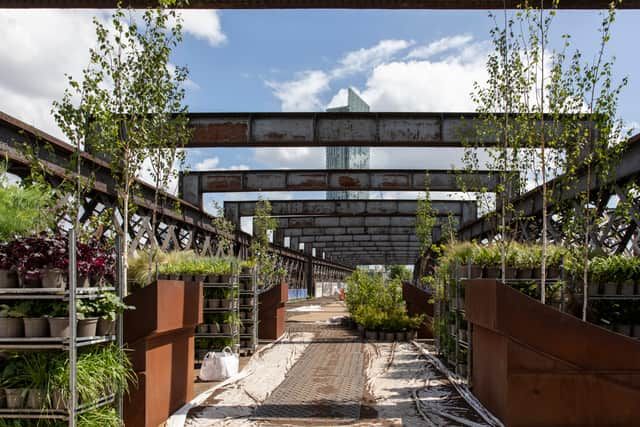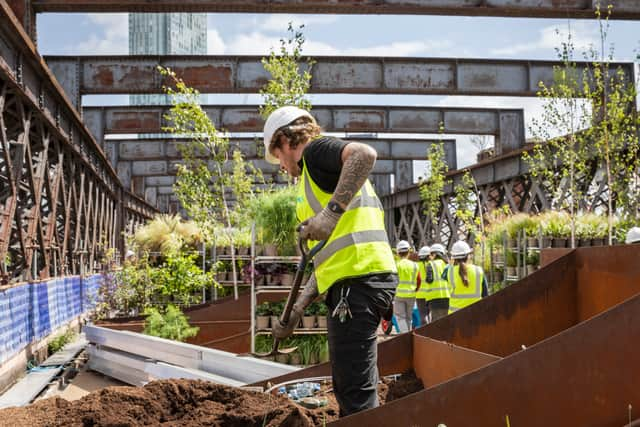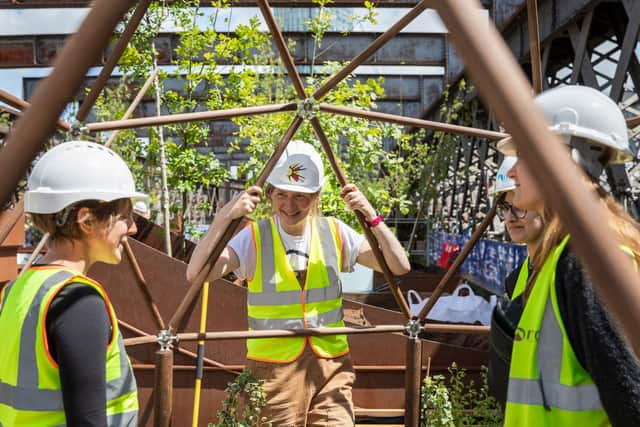Castlefield Viaduct: landmark viaduct transformed into ‘sky park’ for July opening
This article contains affiliate links. We may earn a small commission on items purchased through this article, but that does not affect our editorial judgement.
and live on Freeview channel 276
Work is under way on planting as Castlefield Viaduct as the Victorian landmark is transformed into an urban ‘sky park’.
National Trust gardening specialists and apprentices are busy planting 3,000 trees, flowers and shrubs on the derelict structure as it is turned into a new green space for the Castlefield area of Manchester.
Advertisement
Hide AdAdvertisement
Hide AdThe idea is to create a temporary urban park on the listed viaduct and then use that to gauge public opinion on what the longer-term future of the landmark should be.
The ‘sky park’ is set to open to Mancunians later this summer.


What is happening at Castlefield Viaduct?
The National Trust, which is leading the project, is putting in a variety of planting displays for visitors to enjoy as they walk along the viaduct.
These include an area of native plants, shrubs and trees, and a show garden at the end.


Advertisement
Hide AdAdvertisement
Hide AdThe idea is for the park to bring more nature to the Castlefield area of the city and at the same time celebrate the industrial heritage of the viaduct, with planters which are shaped to mirror the curve of the structure and are the same width as the railway tracks that once transported goods across the structure to the Great Northern Warehouse.
A section of the viaduct is also being left untouched to show how nature has reclaimed the space since the site closed in the late 1960s.
The choice of plants take inspiration from what had already started to grow on the viaduct with shrubs, ferns and grasses alongside colourful seasonal planting.
Sections of the planting will mimic the diamond shape of the viaduct’s criss-cross steelwork, achieved through diagonal blossom hedges and other plants.
Advertisement
Hide AdAdvertisement
Hide AdThe original ballast surface is being incorporated into the scheme with 280 sandbags built up at varying heights to create planters which are being brought to life with broom, fennel, grasses, ferns, euphorbias, sedums, fleabane, buddleja, teasle, liriope and phlomis.
A canopy is also being created using 600 half-hardy annual climbers and others including hops and clematis which will tumble down.
The sky park is due to open to the public in July and the Trust aims to use the temporary urban green space to gain visitors’ views on what should eventually happen to the Grade II listed structure.
Is anybody else involved?
As well as the areas being created and designed by the National Trust four areas of the viaduct have been handed over to partner organisations to create their own gardens.
Advertisement
Hide AdAdvertisement
Hide AdThese partner plots belong to Urban Wilderness, the Science and Industry Museum, City of Trees and the Castlefield Forum and they are also in the final stages of completion.
Urban Wilderness is working with Manchester-based charity 42nd Street, which supports young people who have suffered mental health challenges. Their Garden of Possibilities features a geodesic dome and plants which are known for having positive effects on mental health including nettle, feverfew and lemon balm.


The Science and Industry Museum has taken inspiration from its site, which was once a station at the terminus of the Liverpool and Manchester Railway, the world’s first steam-powered intercity railroad. It has chosen fluffy white plants to represents the plumes of steam from the locomotives, blue flowers which cascade and flow to suggest a relationship with water, and decorative pipework and hand-cut trellis panels with patterns designed to evoke the idea of connectivity.
City of Trees’ partner plot is called Trees – Past, Present and Future and aims to showcase trees, shrubs and flowers that have been used throughout the Industrial Revolution, are significant in Manchester today, and will play a role in the city’s response to climate change in the future. These include box, gooseberry, damson and comfrey.
Advertisement
Hide AdAdvertisement
Hide AdCastlefield Forum has come up with an area with plants which reflect the distinct features of Castlefield in both colour and scale, bringing to mind the Industrial Revolution, the Victorian era of warehouses and even the city’s Roman past. It also has an artwork created in partnership with the Saul Hay Gallery.
How can I visit the viaduct?
When the urban park opens to visitors in July, 100 people a day will be able to visit.
Entry onto the structure will be free, but a booking system will be in place to help manage numbers.
As part of the experience, visitors will be able to join a guided walk on the viaduct.
Advertisement
Hide AdAdvertisement
Hide AdThe green space will stretch around halfway across the viaduct, and visitors will also be able to find out more about the viaduct’s heritage, the city’s long relationship with plants and trees and pick up some urban gardening tips.
To find out more, visit the National Trust’s website here.
What has been said about the project?
Sophie Wardell, urban places programme manager at the National Trust, said: “So much hard work has gone into getting the viaduct to this point and we couldn’t have got this far without the support of our partners and those who have helped make this happen for Manchester.
“A little over 12 months ago we’d only just shared the artist illustrations of what the viaduct could look like, and now it’s becoming a reality.
“This first year is an experiment for us to see what people want Castlefield Viaduct to be in the future and we’re excited to hear what ideas they have.”
Advertisement
Hide AdAdvertisement
Hide AdPamela Smith, senior national consultant for gardens and parklands at the National Trust, said: “We’ve reached an exciting stage in the project to transform Castlefield Viaduct into a green space for the people of Manchester.
“Creating a garden on an industrial heritage structure such as this is untested territory for us and we’re intrigued to see how the plant life will take to its new surroundings.
“In addition to greening up a heritage structure, we’re celebrating Manchester’s history adding the county flower, cotton grass, to the viaduct as well as fern species once collected by Manchester suffragist and botanist, Lydia Becker.”
Amy Watson, Castlefield gardener at the National Trust, said: “Castlefield Viaduct is unlike any other garden in the National Trust’s care and we’ll be keeping a close eye on the garden to see how it gets on over the next 12 months.
Advertisement
Hide AdAdvertisement
Hide Ad“I’ll be working with a team of dedicated volunteers and apprentices to plant bulbs on a regular basis and adding to the planting to make sure there’s plenty to see throughout the year.
“We’ll also be working closely with our partners to see how their gardens are responding to their unique surroundings.”
Comment Guidelines
National World encourages reader discussion on our stories. User feedback, insights and back-and-forth exchanges add a rich layer of context to reporting. Please review our Community Guidelines before commenting.
